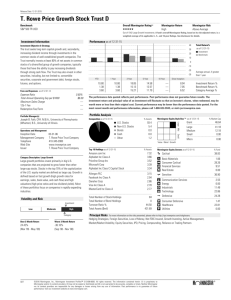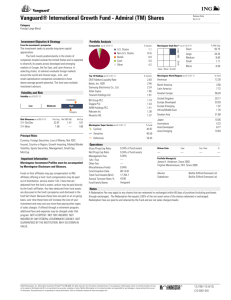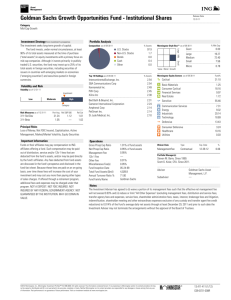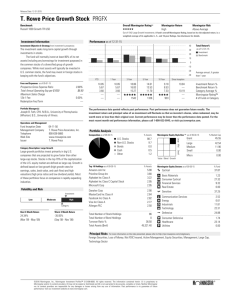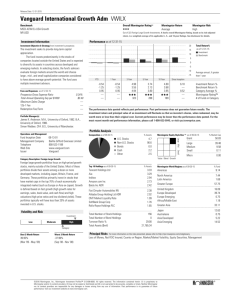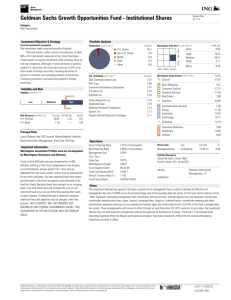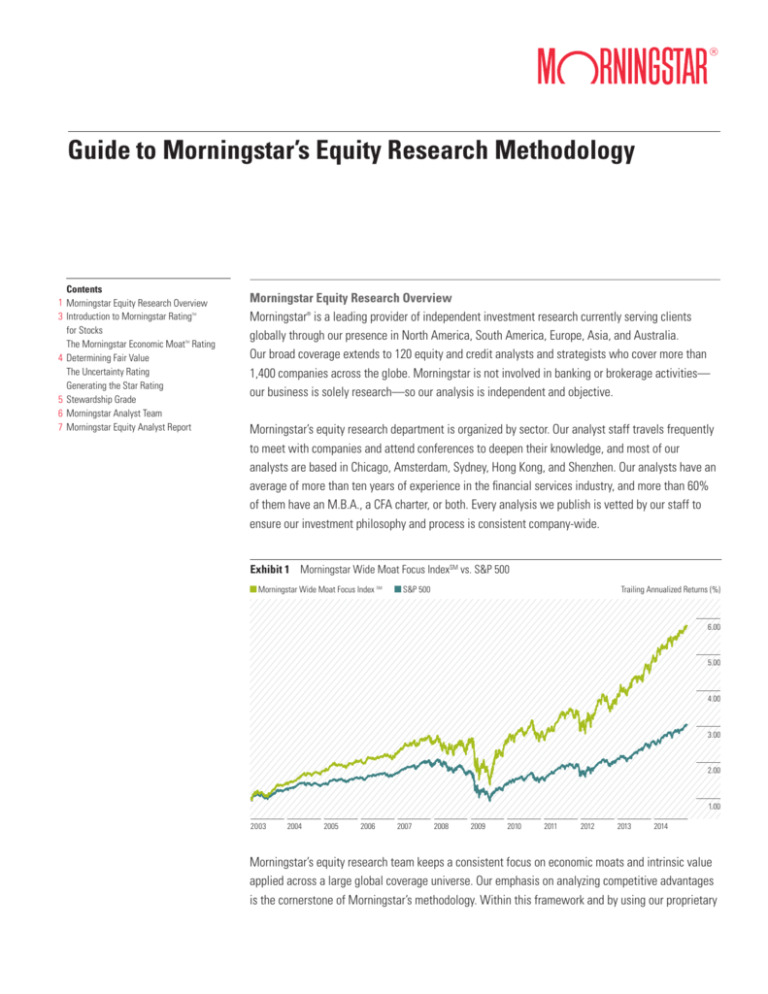
Guide to Morningstar’s Equity Research Methodology
Contents
1 Morningstar Equity Research Overview
3 Introduction to Morningstar Rating
for Stocks
The Morningstar Economic Moat Rating
4 Determining Fair Value
The Uncertainty Rating
Generating the Star Rating
5 Stewardship Grade
6 Morningstar Analyst Team
7 Morningstar Equity Analyst Report
TM
TM
Morningstar Equity Research Overview
Morningstar is a leading provider of independent investment research currently serving clients
globally through our presence in North America, South America, Europe, Asia, and Australia.
Our broad coverage extends to 120 equity and credit analysts and strategists who cover more than
1,400 companies across the globe. Morningstar is not involved in banking or brokerage activities—
our business is solely research—so our analysis is independent and objective.
®
Morningstar’s equity research department is organized by sector. Our analyst staff travels frequently
to meet with companies and attend conferences to deepen their knowledge, and most of our
analysts are based in Chicago, Amsterdam, Sydney, Hong Kong, and Shenzhen. Our analysts have an
average of more than ten years of experience in the financial services industry, and more than 60%
of them have an M.B.A., a CFA charter, or both. Every analysis we publish is vetted by our staff to
ensure our investment philosophy and process is consistent company-wide.
Exhibit 1 Morningstar Wide Moat Focus IndexSM vs. S&P 500
Morningstar Wide Moat Focus Index SM
Trailing Annualized Returns (%)
S&P 500
6.00
5.00
4.00
3.00
2.00
1.00
2003
2004
2005
2006
2007
2008
2009
2010
2011
2012
2013
2014
Morningstar’s equity research team keeps a consistent focus on economic moats and intrinsic value
applied across a large global coverage universe. Our emphasis on analyzing competitive advantages
is the cornerstone of Morningstar’s methodology. Within this framework and by using our proprietary
Page 2 of 9
Guide to Morningstar’s Equity Research Methodology
3 three-stage free cash flow model, each stock within our universe is assigned a fair value estimate.
3 We then assign an uncertainty rating based on multiple fundamental factors, which dictates the
3 appropriate margin of safety required before recommending the stock.
Morningstar’s research is distributed through multiple channels to help investors, advisors, research
analysts, and asset managers make informed decisions, and our fundamental approach to research
and investing has produced exceptional results over time. Our proprietary Morningstar® Wide Moat
Focus IndexSM—which buys the 20 cheapest wide-moat stocks in our universe each quarter—has
outperformed the S&P 500 by over 6% annually since its inception in 2002, as of June 2014.*
Exhibit 2 Morningstar Approach to Equity Research
Fundamental
Analysis
Morningstar ® Economic
Moat Rating™
Company
Valuation
Fair Value
Estimate
Uncertainty
Assessment
Star Rating
Analyst conducts
company and
industry research:
Analysts rate the
strength of competitive
advantage, or moat:
None, Narrow, or Wide
Analyst considers
past financial results
and focuses on
competitive position
and future prospects
to forecast cash flows.
Analyst uses a
discounted cash-flow
model to develop
a Fair Value Estimate,
which serves as
the foundation for the
Morningstar Rating™
for stocks.
The analyst then
evaluates the range of
potential intrinsic
values for the company
and assigns an
uncertainty rating:
Low, Medium,
High, Very High,
or Extreme.
The current stock price
relative to Morningstar’s
Fair Value Estimate,
adjusted for uncertainty,
determines the
Morningstar Rating
for stocks.
Financial statement
analysis
Channel checks
Advantages that
confer a moat:
Trade-show visits
High Switching Costs
(Microsoft)
Industry and company
reports and journals
Cost advantage
(Wal-Mart)
Conference calls
Intangible assets
(Johnson & Johnson)
Management and
site visits
Network Effect
(Mastercard)
Analyst enters
assumptions into
Morningstar’s
proprietary discounted
cash-flow model.
The uncertainty rating
determines the margin
of safety required before
the analyst recommends
the stock. The higher the
uncertainty, the wider
the margin of safety.
Efficient Scale
(Lockheed Martin)
©2014 Morningstar. All rights reserved. The information, data, analyses, and opinions contained herein (1) are proprietary to Morningstar, Inc. and its affiliates (collectively, “Morningstar”), (2) may not be copied or
redistributed, (3) do not constitute investment advice offered by Morningstar (4) are provided solely for informational purposes and therefore are not an offer to buy or sell a security, and (5) are not warranted
to be accurate, complete, or timely. Morningstar shall not be responsible for any trading decisions, damages, or other losses resulting from, or related to, this information, data, analyses or opinions or their use.
Past performance is no guarantee of future results. *Reflects correct performance statistics as of June 30, 2014.
The Morningstar Rating
for stocks is updated
each evening after the
market closes.
Page 3 of 9
Guide to Morningstar’s Equity Research Methodology
3 Introduction to Morningstar RatingTM for Stocks
3 We believe that a company’s intrinsic worth results from the future cash flows it can generate.
3 The Morningstar Rating for stocks identifies stocks trading at a discount or premium to their intrinsic
worth—or fair value estimate, in Morningstar terminology. Stocks rated as 5-star sell for the
biggest risk-adjusted discount to their fair values, whereas 1-star stocks trade at premiums to their
intrinsic worth.
Four key components drive the Morningstar Rating for stocks:
1. Our assessment of the firm’s economic moat
2. Our estimate of the stock’s fair value
3. Our uncertainty around that fair value estimate
4. The current market price
This process ultimately culminates in our star rating. Underlying this rating is a fundamentallyfocused methodology and a robust, standardized set of procedures and core valuation tools used by
Morningstar’s equity analysts.
The Morningstar® Economic Moat™ Rating
The concept of an economic moat—a term Warren Buffett uses to describe the sustainability of a
company’s future economic profits—plays a vital role in our qualitative assessment of a firm’s
long-term investment potential and in our fair value estimates. We assign one of three Morningstar
Economic Moat Ratings: none, narrow, or wide. There are two major requirements for firms to earn
either a narrow or wide rating: 1. The prospect of earning above-average returns on capital; and 2.
Some competitive edge that prevents these returns from quickly eroding.
®
™
Exhibit 3 Morningstar Rating Calculation Adjusted for Uncertainty
Q QQ QQQ QQQQ QQQQQ
Price/Fair Value
2.00
175%
1.75
155%
1.50
135%
125%
95%
80%
115%
110%
105%
90%
125%
85%
1.25
1.00
80%
70%
0.75
60%
Low
Medium
High
©2014 Morningstar. All rights reserved. The information, data, analyses, and opinions contained herein (1) are proprietary to Morningstar, Inc. and its affiliates (collectively, “Morningstar”), (2) may not be copied or
redistributed, (3) do not constitute investment advice offered by Morningstar (4) are provided solely for informational purposes and therefore are not an offer to buy or sell a security, and (5) are not warranted
to be accurate, complete, or timely. Morningstar shall not be responsible for any trading decisions, damages, or other losses resulting from, or related to, this information, data, analyses or opinions or their use.
Past performance is no guarantee of future results. *Reflects correct performance statistics as of June 30, 2014.
50%
Very High
0.50
Page 4 of 9
Guide to Morningstar’s Equity Research Methodology
3 Determining Fair Value
3 At the heart of our valuation system is a detailed projection of a company’s future cash flows,
3 resulting from our analysts’ independent primary research. Analysts create custom industry and
company assumptions to feed income statement, balance sheet, and capital investment assumptions
into our standardized, proprietary Discounted Cash Flow modeling templates. By combining our
analyst inputs with the moat rating, our models fade a firm’s Returns on Invested Capital and
earnings growth rate from the end of an analyst’s explicit forecast horizon until the perpetuity period.
The Uncertainty Rating
Morningstar’s Uncertainty Rating captures the range of potential intrinsic values for a company and
uses it to assign the margin of safety required before investing. The Uncertainty Rating represents
the analysts’ ability to bound the value of the shares in a company around the Fair Value Estimate,
based on the characteristics of the underlying business. To formalize the process for quantifying the
uncertainty in placing a value on a company, our framework breaks down the uncertainty around
company value to four simplified conceptual elements: range of sales, operating leverage, financial
leverage, and contingent events.
Uncertainty = Range of sales * operating leverage * financial leverage + contingent event discount
Exhibit 4 Market Valuation
Generating the Star Rating
Once we determine the fair value of a stock, we compare it to the stock’s current market price on a
daily basis, and the star rating is automatically re-calculated at the market close every day the
market is open. Our analysts keep close tabs on the companies they follow daily, and based on
thorough and ongoing analysis, raise or lower their fair value estimates as warranted. It is also worth
noting that there are no predefined distributions of stars. That is, the percentage of stocks that earn
5 stars can fluctuate daily, so the star ratings, in the aggregate, can serve as a gauge of the broader
©2014 Morningstar. All rights reserved. The information, data, analyses, and opinions contained herein (1) are proprietary to Morningstar, Inc. and its affiliates (collectively, “Morningstar”), (2) may not be copied or
redistributed, (3) do not constitute investment advice offered by Morningstar (4) are provided solely for informational purposes and therefore are not an offer to buy or sell a security, and (5) are not warranted
to be accurate, complete, or timely. Morningstar shall not be responsible for any trading decisions, damages, or other losses resulting from, or related to, this information, data, analyses or opinions or their use.
Past performance is no guarantee of future results. *Reflects correct performance statistics as of June 30, 2014.
Page 5 of 9
Guide to Morningstar’s Equity Research Methodology
3 market’s valuation. When there are many 5-star stocks, the stock market as a whole is more
3 undervalued than when very few companies garner our highest rating.
3
Stewardship Grade
The Morningstar Stewardship Grade represents our assessment of management’s stewardship
of shareholder capital, with particular emphasis on capital allocation decisions. Analysts consider a
company’s investment strategy, history of investment timing and valuation, financial leverage,
dividend and share buyback policies, execution, management compensation, related party
transactions, and accounting practices. Corporate governance practices, such as poison pills and
staggered boards, are only considered if they’ve had a demonstrated impact on shareholder value.
Analysts assign one of three stewardship ratings: “exemplary,” “standard,” and “poor.” Analysts
judge stewardship from an equity holder’s perspective. Ratings are determined on an absolute basis.
Companies are judged not against peers within their industry, but against ideal stewardship of
shareholder capital. Most companies will receive a standard rating, and this should be considered
the default rating in the absence of evidence that a management team has made exceptionally
strong or poor capital allocation decisions.
®
SM
A history of value-accretive acquisitions, optimal financial leverage, ideal dividend and share buyback
policies, and investments that enhance competitive advantages—these are the marks of exemplary
Exhibit 5 Morningstar Equity Analyst Team Structure
Director
Basic Materials
r
Director
yu
Financial Services and Real Estate
Director
ts
Consumer Defensive and Cyclical
Director
Energy
f
Director
Utilities
o
Director of
Corporate Credit
Research
Director
Industrials
p
Quantitative
Analysts
Director
ai
Technology and Communication Serivces
Strategists
Director of Economic Analysts
▲
▲
Global Director of
Equity and
Credit Research
Director of Equity
Research
North America
rtyusdfopai
Credit Analysts
rtyusdfopai
Associate Directors
rtyusdfopai
Senior Analysts
▲
d
▲
Director
Healthcare
Director of Equity
Research
Asia-Pacific
Director of Equity Operations
©2014 Morningstar. All rights reserved. The information, data, analyses, and opinions contained herein (1) are proprietary to Morningstar, Inc. and its affiliates (collectively, “Morningstar”), (2) may not be copied or
redistributed, (3) do not constitute investment advice offered by Morningstar (4) are provided solely for informational purposes and therefore are not an offer to buy or sell a security, and (5) are not warranted
to be accurate, complete, or timely. Morningstar shall not be responsible for any trading decisions, damages, or other losses resulting from, or related to, this information, data, analyses or opinions or their use.
Past performance is no guarantee of future results. *Reflects correct performance statistics as of June 30, 2014.
rtyusdfopai
Equity Analysts
Page 6 of 9
Guide to Morningstar’s Equity Research Methodology
3 stewards of shareholder capital. Certain corporate practices, such as poison pills and staggered
3 boards, are easily visible and garner much attention in governance analysis circles. Unfortunately,
3 focusing on particular governance practices tends to poorly predict a firm’s ability to generate
improving returns on invested capital and shareholder returns. Fundamental investors should instead
conduct a more thorough analysis of management stewardship of shareholder capital.
Morningstar Analyst Team
Morningstar’s team structure emphasizes deep bottom-up research while maintaining consistency
across our coverage universe. Individual analysts focus on narrow industry segments and examine
the critical issues confronting the companies they cover. Senior analysts and team leaders surface
themes and guide the research, also coordinating macro inputs across industries (e.g. same oil price
assumptions in energy team’s models), and associate directors provide a sector overview. The team
emphasizes surfacing ideas and uncovering opportunities that represent value not yet recognized by
the market.
Morningstar Equity Analyst Report
Morningstar’s Equity Analyst Report delivers Morningstar’s holistic view on a stock. It conveys
Morningstar’s qualitative and quantitative ratings on the stock, as well as written research from the
Morningstar analyst who covers it. Analyst reports on over 1,400 stocks demonstrate a stock’s
valuation and what investment considerations should be.
©2014 Morningstar. All rights reserved. The information, data, analyses, and opinions contained herein (1) are proprietary to Morningstar, Inc. and its affiliates (collectively, “Morningstar”), (2) may not be copied or
redistributed, (3) do not constitute investment advice offered by Morningstar (4) are provided solely for informational purposes and therefore are not an offer to buy or sell a security, and (5) are not warranted
to be accurate, complete, or timely. Morningstar shall not be responsible for any trading decisions, damages, or other losses resulting from, or related to, this information, data, analyses or opinions or their use.
Past performance is no guarantee of future results. *Reflects correct performance statistics as of June 30, 2014.
Page 7 of 9
Guide to Morningstar’s Equity Research Methodology
Morningstar Equity
Analyst Report Features
3
3
The Morningstar Rating™ for stocks is calculated
3 by
comparing a stock’s current market price with Morningstar’s
fair value estimate of the stock, culminating in our
star rating. Ratings are updated daily and can therefore
change daily.
The “Fair Value Estimate” is a Morningstar analyst’s
estimate of what a stock is worth, calculated by determining
how much we would pay today for all the streams of excess
cash generated by the company in the future. We arrive
at this value by forecasting a company’s future financial performance using a detailed discounted cash-flow model.
This differs from the “Quantitative Fair Value Estimate,” which
quantitatively calculates the fair value, based on the
analyst-driven ratings of comparable companies. Empirically,
we find quantitative ratings and analyst-driven ratings to
be equally powerful predictors of future performance. When
the analyst driven rating and the quantitative rating agree,
we find the ratings to be much more predictive than when they
differ. In this way, they provide an excellent second opinion
for each other. When the ratings differ, it may be wise to follow
the analyst’s rating for a truly unique company with its
own special situation, and follow the quantitative rating when
a company has several reasonable comparable companies
and relevant information is flowing at a rapid pace.
The “Price/Fair Value” ratio is calculated by dividing the
last price by the “Fair Value Estimate.” It indicates whether
a stock is currently overvalued, undervalued, or fairly valued,
according to the fair value estimate. A price/fair value
ratio of less than 1 indicates the stock is undervalued, while
a price/fair value ratio of more than 1 indicates a stock
is overvalued.
Our corporate “Stewardship” rating represents our
assessment of management’s stewardship of shareholder
capital, with particular emphasis on capital allocation
decisions. Analysts assign one of three stewardship ratings:
exemplary, standard, or poor. Most companies will receive
a standard rating, and this should be considered the
default rating in the absence of evidence that a management
team has made exceptionally strong or poor capital
allocation decisions.
The Morningstar Economic Moat Rating refers to how
likely a company is to keep competitors at bay for an
extended period. We classify companies as No-Moat,
Narrow-Moat, and Wide-Moat.
The “Uncertainty Rating” describes our level of
uncertainty about the accuracy of our fair value estimate.
The lower the uncertainty, the narrower the potential range
of outcomes for that particular company. The rating is
expressed as low, medium, high, very high, or extreme.
Morningstar Equity Analyst Report | Report as of 29 Jul 2014 | Page 1 of 12
Apple Inc AAPL (XNAS)
Morningstar Rating
QQQ
29 Jul 2014
Last Price
Fair Value Estimate
Price/Fair Value
98.38 USD
87.00 USD
1.13
29 Jul 2014
Morningstar Pillars
Analyst
Quantitative
Economic Moat
Valuation
Uncertainty
Financial Health
Narrow
QQQ
High
AA-
Wide
Overvalued
Medium
Strong
Source: Morningstar Equity Research
Quantitative Valuation
AAPL
USAa
Undervalued
Price/Intrinsic Value
Price/Earnings
Forward P/E
Price/Cash Flow
Price/Free Cash Flow
Dividend Yield %
Fairly Valued
Overvalued
Current
5-Yr Avg
1.07
16.0
14.0
10.9
12.8
1.79
0.93
15.2
—
11.3
13.2
—
Sector Country
1.02
21.1
15.0
13.3
18.4
1.61
1.00
20.8
15.3
12.4
20.8
1.97
Dividend Yield %
Market Cap (Bil)
Industry
Stewardship
1.79
589.09
Consumer Electronics
Standard
29 Jul 2014
29 Jul 2014
Apple is driving software and services innovation to capture premium
pricing on hardware.
Brian Colello, CPA, 22 July 2014
Analyst Note
Investment Thesis
Apple reported solid third-quarter earnings, and gave
investors a fourth-quarter outlook that was relatively in
line with our expectations. However, the bigger story
continues to revolve around buzz for the company’s
upcoming products (iPhone 6, new iPads, and a possible
iWatch). Management has set a bullish tone for its product
pipeline and for revenue growth this holiday season. We
expect to maintain our $87 fair value estimate, and Apple's
narrow economic moat rating.
We believe Apple's strength lies in its experience and
expertise in integrating hardware, software, services, and
third-party applications into differentiated devices that
allow Apple to capture a premium on hardware sales.
Although Apple has a sterling brand, strong product
pipeline, and ample opportunity to gain share in its various
end markets, short product life cycles and intense
competition will prevent the firm from resting on its
laurels, or carving out a wide economic moat, in our
opinion.
Source: Morningstar
Bulls Say
OSmartphones should continue to grow as a
piece of the total handset pie. This bodes well for
future iPhone sales.
OApple's iPhone and iOS operating system have
consistently been rated at the head of the pack in
terms of customer loyalty, engagement and
security, which bodes well for the firm's ability to
retain customers in the long-term.
OFor each iOS device purchased, customers may
be less likely to switch to another provider and
more likely to buy repeat Apple products, which
we view as a good sign for long-term hardware
and iTunes revenue.
Bears Say
OApple’s recent decisions to maintain a premium
pricing strategy may help fend off gross margin
compression but may also limit unit sales and
market share as the low end of the smartphone
space will likely grow faster than the premium
market.
OWhereas Apple focuses on a handful of key
products, Samsung has emerged as a strong rival
by offering highly competitive devices of all sizes
and prices at all times of the year.
OSome may question whether Apple has lost
much of its vision and creativity with the passing
of cofounder Steve Jobs in October 2011.
We believe Apple has developed a narrow economic
moat, thanks to switching costs related to many attributes
around the iOS platform that may make current iOS users
more reluctant to stray outside the Apple ecosystem for
future purchases. In our view, much of Apple's exponential
growth in recent years has stemmed not from the firm's
economic moat, but from the achievement of building the
first truly revolutionary smartphone, the iPhone, that
integrated hardware and software, as well as a robust
apps store and ecosystem that attracted new users to
platform. Apple's first-mover advantage may be
diminishing, and "easy growth" coming from early
smartphone adopters may be winding down as the
smartphone market moves up the adoption curve and
competition ramps up. Yet we still foresee iPhone growth,
coming from both attracting new customers to iOS (mostly
in emerging markets, although we still see U.S. growth
as well) and retaining Apple's existing premium iPhone
customers, where we think the company's moat will play
an increasingly important role. A partnership with China
Mobile, the world’s largest wireless carrier, should also
give iPhone growth a shot in the arm.
Ultimately, we think future smartphone and tablet
competition will stem from software and services, as
hardware is already approaching commoditization. We
view Apple as well positioned to develop and expand
enough services to enhance the user experience, in order
to build switching costs that will help the firm retain
customers and generate significant repeat purchases will
be critical for future iPhone growth in the years ahead.
Brian Colello, CPA, 22 July 2014
Apple’s $37.4 billion in quarterly revenue modestly trailed
expectations, as it failed to reach the high end of its
previously forecasted range of $36 billion to $38 billion.
IPhone unit sales of 35.2 million were a shade below our
expectations, but still relatively strong. iPad unit sales of
13.3 million were down 9% from the year-ago quarter,
mainly due to soft sales in developed markets. However,
Mac sales and iTunes revenue grew nicely, as did revenue
from China (iPhone, iPad and Mac sales in the region were
up 48%, 50%-plus and 39% from the year-ago quarter,
respectively). Favorable component pricing helped Apple
earn a healthy 39.4% gross margin, above expectations.
Apple projects revenue of $37 billion to $40 billion in the
September quarter, which we think implies modest iPhone
unit sales growth, to the mid-to-high 30 million unit range.
Management was upbeat about its product pipeline and
growth opportunities for the critically important holiday
season. One concern around iPhone growth stems from
changes to wireless carrier plans in the U.S., but Apple
commented that programs like AT&T Next, which allow
for early upgrades, are a net positive for the firm. Apple
also expects to revitalize iPad demand with product
enhancements. Combined with ongoing traction at China
Mobile and reports that the firm is asking its suppliers to
build over 70 million new iPhones for its impending launch,
Apple may be well positioned for hearty sales growth later
this year.
Economic Moat
Brian Colello, CPA 22 July 2014
We believe Apple has a narrow economic moat based on
modest, but not insurmountable, customer switching
costs. We don't believe these switching costs are critical
factors in attracting new iOS customers, especially in
© 2014 Morningstar. All Rights Reserved. Unless otherwise provided in a separate agreement, you may use this report only in the country in which its original distributor is based. Data as originally reported. The information contained
herein is not represented or warranted to be accurate, correct, complete, or timely. This report is for information purposes only, and should not be considered a solicitation to buy or sell any security. Redistribution is prohibited without
written permission. To order reprints, call +1 312-696-6100. To license the research, call +1 312-696-6869. See last page for important disclosures.
Corporate Credit Rating: The analyst financial-health
grade consists of two components that are weighted to
arrive at an overall financial-health grade:
1. Raw financial health. We look at financial leverage (assets/equity) from the most recent quarter’s
balance sheet, cash on the balance sheet, cash flows, and free cash flows to arrive at a financial-health grade.
2. Trend. We punish companies with deteriorating
financial health.
The “Bulls Say” section gives reasons the stock might
perform well in the near future.
?
The “Bears Say” section explains possible challenges
for the company or its sector in the near future.
The “Investment Thesis” is Morningstar’s opinion on
the stock’s potential for growth. This section cites specific
reasons why the analyst believes the stock is or is not a
good investment.
Under “Analyst Note,” the Morningstar analyst covering
the stock summarizes its recent performance and makes
an educated guess about its potential future performance.
This section states whether we believe the stock has a
moat, and why.
©2014 Morningstar. All rights reserved. The information, data, analyses, and opinions contained herein (1) are proprietary to Morningstar, Inc. and its affiliates (collectively, “Morningstar”), (2) may not be copied or
redistributed, (3) do not constitute investment advice offered by Morningstar (4) are provided solely for informational purposes and therefore are not an offer to buy or sell a security, and (5) are not warranted
to be accurate, complete, or timely. Morningstar shall not be responsible for any trading decisions, damages, or other losses resulting from, or related to, this information, data, analyses or opinions or their use.
Past performance is no guarantee of future results. *Reflects correct performance statistics as of June 30, 2014.
Page 8 of 9
Guide to Morningstar’s Equity Research Methodology
3
3
In the “Valuation” section, the analyst gives the3rationale
behind Morningstar’s fair value estimate. Any recent changes
in the estimate are explained.
Morningstar Equity Analyst Report |Page 3 of 12
Apple Inc AAPL (XNAS)
Morningstar Rating
QQQ
The “Risk” section lists factors that could hurt the
stock’s performance.
The “Management” section takes a look at the
company’s leadership and evaluates how well they have
managed the business.
29 Jul 2014
Last Price
Fair Value Estimate
Price/Fair Value
98.38 USD
87.00 USD
1.13
29 Jul 2014
Dividend Yield %
Market Cap (Bil)
Industry
Stewardship
1.79
589.09
Consumer Electronics
Standard
29 Jul 2014
29 Jul 2014
apps store is likely helping Apple attract new customers.
However, these same developers likely build for Android
as well, so we think that developers will flock to the
ecosystem that offers the most attractive return on
investment. Finally, Apple may have some cost
advantages associated with its supply chain, such as
squeezing suppliers or making massive purchases of flash
memory and other key components. However, we believe
these advantages are predicated on the enormous
forecast volume of Apple's products, and we suspect
these advantages would evaporate if Apple's device
production were to shrink.
Valuation
Brian Colello, CPA 22 July 2014
Our fair value estimate for Apple is $87 per share, which
implies fiscal 2014 (ending September 2014)
price/earnings of 14 times (and only 10 times after
excluding Apple’s cash balance on hand). We project 5%
revenue growth in fiscal 2014 and 9% iPhone revenue
growth, as iPhone 5s sales grow at a nice pace, especially
in China where a recent partnership with China Mobile,
the world’s largest wireless carrier, should contribute to
healthy iPhone unit sales growth. We project a 6%
revenue decline from iPad, but 9% sales growth from Mac.
Longer term, Apple should still attract late smartphone
adopters in developed markets and new customers in
emerging markets (especially China). As more consumers
are previous smartphone owners, rather than first-time
buyers, we think Apple has a good chance to retain a
sizable portion of its iOS user base today, and perhaps
gain further share at the high end of the market. However,
although Apple has taken on the strategy of maintaining
premium pricing, which may support gross margins in the
years ahead, such pricing may weigh on future revenue
growth. In turn, we model decent iPhone revenue growth
in the next two years, but only low single-digit iPhone
revenue growth in fiscal 2016 and beyond.
Based on recent lackluster iPad sales, we project iPad
revenue to decline in fiscal 2014, and remain relatively
flattish in the long term. We anticipate intense
competition in the tablet space, as well as headwinds to
tablet adoption, as more customers simply opt to rely on
large-screen smartphones rather than standalone tablets.
We assume Apple's line of Mac PCs will gain share in the
declining PC industry but that revenue will be flattish as
pricing softens on these products. We also do not make
any profitability assumptions for an Apple TV or iWatch,
but recognize that future innovations may provide upside
to our valuation.
We project 39% gross margins in fiscal 2014 and
mid-to-high 30% gross margins in the long term. In turn,
operating margins hover in the mid-to-high 20% range.
Our fair value uncertainty rating for Apple remains high.
Risk
Brian Colello, CPA 22 July 2014
We believe a large, well-diversified company like Apple
faces several risks. Smartphone and tablet competition is
rising, as Samsung, in particular, has developed
compelling iPhone alternatives in the premium
smartphone space. Meanwhile, we anticipate that a
greater portion of smartphone sales come from low-end
devices in emerging markets where Apple does not
participate. If these devices turn out to offer only a slightly
worse user experience than iOS products, Apple may be
unable to capture an adequate premium on future
hardware sales. Apple also has to square off against
several competitors with different strategies and financial
profiles, as firms like Amazon (with its Kindle Fire tablet),
Google (with its Nexus devices) and Xiaomi appear willing
to sell hardware at close to cost, in order to drive other
revenue streams.
Management
Brian Colello, CPA 22 July 2014
We view Apple as a good steward of shareholder capital.
Arthur Levinson, former chairman and CEO of Genentech,
is chairman of Apple's board of directors. Tim Cook
became CEO in August 2011 after cofounder, longtime
CEO, and visionary Steve Jobs stepped down from the
CEO role before passing away in October 2011. Cook was
considered to be Jobs' right-hand man and served in
various operations roles with Apple before becoming COO
in 2005. We believe Jobs' passing was a blow to the firm,
as he was a one-of-a-kind leader and creative mind.
© 2014 Morningstar. All Rights Reserved. Unless otherwise provided in a separate agreement, you may use this report only in the country in which its original distributor is based. Data as originally reported. The information contained
herein is not represented or warranted to be accurate, correct, complete, or timely. This report is for information purposes only, and should not be considered a solicitation to buy or sell any security. Redistribution is prohibited without
written permission. To order reprints, call +1 312-696-6100. To license the research, call +1 312-696-6869. See last page for important disclosures.
©2014 Morningstar. All rights reserved. The information, data, analyses, and opinions contained herein (1) are proprietary to Morningstar, Inc. and its affiliates (collectively, “Morningstar”), (2) may not be copied or
redistributed, (3) do not constitute investment advice offered by Morningstar (4) are provided solely for informational purposes and therefore are not an offer to buy or sell a security, and (5) are not warranted
to be accurate, complete, or timely. Morningstar shall not be responsible for any trading decisions, damages, or other losses resulting from, or related to, this information, data, analyses or opinions or their use.
Past performance is no guarantee of future results. *Reflects correct performance statistics as of June 30, 2014.
?
Page 9 of 9
Guide to Morningstar’s Equity Research Methodology
3
3
3
22 West Washington Street
Chicago, IL 60602 USA
©Morningstar 2014. All Rights Reserved. The information, data, analyses and opinions presented herein do not constitute
investment advice; are provided solely for informational purposes and therefore are not an offer to buy or sell a security;
and are not warranted to be correct, complete or accurate. The opinions expressed are as of the date written and are subject
to change without notice. Except as otherwise required by law, Morningstar shall not be responsible for any trading decisions,
damages or other losses resulting from, or related to, the information, data, analyses or opinions or their use. The information
contained herein is the proprietary property of Morningstar and may not be reproduced, in whole or in part, or used in
any manner, without the prior written consent of Morningstar. To order reprints, call +1 312 696-6100. To license the research,
call +1 312 696-6869.


